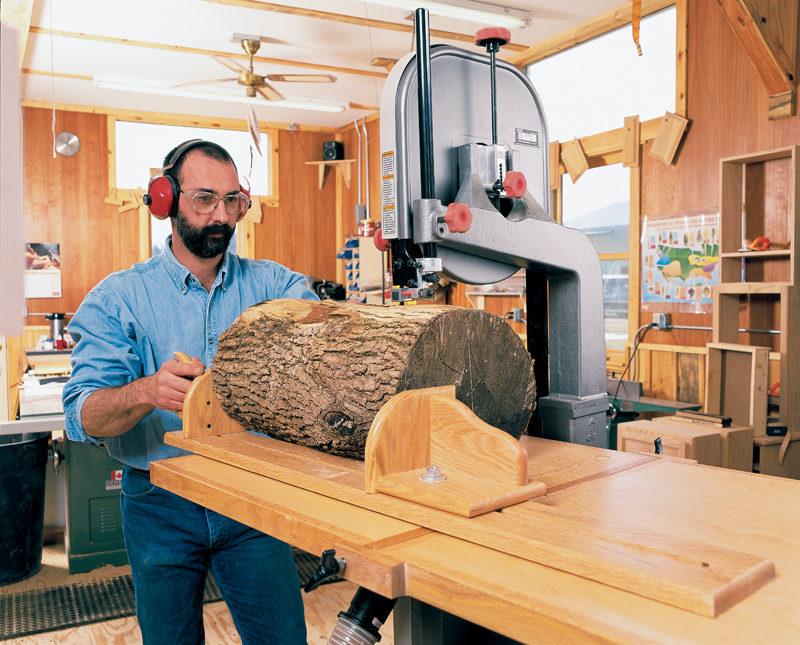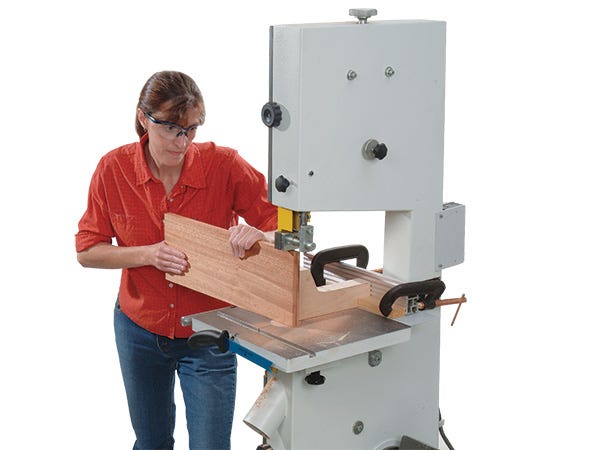If you’ve ever wondered “what does bandsaw resaw mean?” you’re in the right place! In this article, we’ll dive into the fascinating world of woodworking and explore the meaning behind this intriguing term. So, let’s get started and unravel the mystery of bandsaw resaw together!
When it comes to woodworking, the bandsaw is a versatile tool that can perform a wide range of tasks. And one of those tasks is resawing. But what exactly does that mean? Well, imagine you have a thick piece of wood that you want to cut into thinner slices. Resawing with a bandsaw allows you to do just that – it’s a technique that involves cutting a board along its thickness to create thinner pieces.
But why would someone want to resaw a piece of wood? Well, there are several reasons! Resawing opens up a world of possibilities in woodworking. It allows you to create thinner boards for projects like veneering or making bookmatched panels. It also enables you to maximize your resources and get more out of your lumber by transforming larger pieces into multiple thinner ones.
So, whether you’re a woodworking enthusiast or just curious about this term, understanding what bandsaw resaw means can expand your knowledge and inspire your next DIY project. Now that we’ve uncovered the basics, let’s delve even deeper into the art of bandsaw resawing!

What Does Bandsaw Resaw Mean? Understanding the Definition and Application
Bandsaws are versatile tools used in woodworking and metalworking, but what does bandsaw resaw mean? Resawing is a specific technique employed with a bandsaw, allowing woodworkers to cut thinner boards from thicker ones. It is a useful method for maximizing the yield of lumber, creating veneers, or producing precise cuts for various woodworking projects. In this article, we will explore the concept of bandsaw resawing in detail, its benefits, techniques, and common applications.
Bandsaw Resaw Techniques: Unlocking the Potential of Your Bandsaw
Understanding Resawing and Its Benefits
Resawing is the process of cutting a board along its thickness, producing two or more thinner boards. By employing a bandsaw, woodworkers can accurately slice through a wide range of lumber types, including hardwoods and softwoods. The primary benefit of resawing is that it enables the creation of thinner stock for various woodworking applications, such as crafting veneers, producing bookmatched panels, or even creating thinner boards for furniture construction.
In addition to maximizing the use of available lumber, resawing also allows woodworkers to achieve greater control over the grain pattern of the resulting boards. By resawing thicker boards, one can obtain bookmatched panels with beautifully symmetrical grain patterns, adding aesthetic appeal to furniture or cabinetry projects. Moreover, resawing can save money by reducing the need to purchase thin stock or veneers that can be easily produced from thicker boards through the bandsaw resawing technique.
Basic Resawing Techniques and Tips
To achieve successful resaw cuts, it is crucial to set up the bandsaw correctly and follow essential techniques. Here are some tips to help you get started:
1. Blade Selection: Choose a blade specifically designed for resawing, such as wide bandsaw blades with minimal set and a low TPI (teeth per inch) count. The blade’s width contributes to stability during cuts, while a low TPI reduces the risk of excessive heat build-up.
2. Blade Tension and Tracking: Properly tension the bandsaw blade to prevent deflection or drifting during the cut. Adjust the blade tracking to ensure it runs smoothly and accurately along the blade guides.
3. Fence Alignment: Align the fence parallel to the bandsaw blade and adjust it to the desired distance for the desired thickness of the resawn boards. Use a featherboard or hold-downs for added stability and safety.
4. Feed Rate: Maintain a steady and moderate feed rate, allowing the bandsaw blade to do the cutting without forcing it through the material. Applying excessive force can lead to blade wander or binding.
5. Blade Heating: Keep an eye on the blade’s temperature during the resawing process. If the blade becomes too hot, it could lead to premature dulling or even blade damage. Consider using a lubricant or cooling agent to reduce heat build-up.
Remember to practice safe woodworking techniques when performing bandsaw resawing. Always wear appropriate safety gear, such as goggles, a dust mask, and ear protection. Additionally, follow the manufacturer’s guidelines for your specific bandsaw model to ensure optimal results and safety.
Common Applications of Bandsaw Resawing: Going Beyond Thicker Boards
Creating Veneers for Decorative Projects
One of the popular applications of bandsaw resawing is the creation of veneers. Veneers are thin slices of wood used to cover surfaces, providing an attractive decorative element to furniture, cabinets, or musical instruments. By resawing thicker boards into thin sheets, woodworkers can produce their own custom veneers, resulting in unique patterns and textures. Veneers offer versatility in design and can be arranged in various patterns like bookmatching, slip matching, or even marquetry.
Bookmatching for Symmetrical Grain Patterns
Bookmatching is a technique that involves resawing a thicker board and opening it like a book to reveal a symmetrical grain pattern. This technique creates visually stunning panels for tabletops, cabinet doors, or other decorative elements. The mirrored pattern adds a touch of elegance and sophistication to the finished piece, making it a popular choice among woodworkers and furniture makers.
Production of Thin Stock for Furniture Components
Resawing is also employed to produce uniform and thinner stock for furniture components like table aprons, chair legs, or drawer fronts. By resawing thicker boards, woodworkers can create the desired thickness for these components, saving money and allowing for better control over the final product.
In conclusion, bandsaw resawing is a valuable technique for woodworkers to maximize the yield of lumber, create veneers, and produce precise cuts for various woodworking projects. Understanding the principles and techniques of bandsaw resawing opens up endless possibilities for creative woodworking endeavors. So, explore the world of bandsaw resawing, and enhance your woodworking skills and creations.
Key Takeaways: What Does Bandsaw Resaw Mean?
– Resawing is a technique used with a bandsaw to cut boards into thinner pieces.
– Bandsaw resawing allows you to maximize the use of your materials.
– It is commonly used in woodworking to create veneers, panels, and smaller boards.
– Resawing can help you save money by creating thinner pieces from thicker stock.
– Proper setup and choosing the right blade are crucial for successful bandsaw resawing.
Frequently Asked Questions
Welcome to our Frequently Asked Questions page where we’ll address all your burning questions about the term “bandsaw resaw”!
Question 1: What is the meaning of bandsaw resaw?
When we talk about bandsaw resaw, we’re referring to a technique carried out using a bandsaw machine. Resawing involves cutting a thick piece of wood into thinner slices or veneers. It allows you to maximize the utility of your lumber by obtaining multiple thinner boards from a single thick board.
The process requires a special type of blade with fine teeth, designed specifically for resawing. Bandsaw resawing is commonly used in woodworking projects such as creating book-matched veneers, creating thin boards for joinery, or making guitar tops and backs.
Question 2: Why would someone want to use the bandsaw resaw technique?
The bandsaw resaw technique offers several advantages for woodworkers and craftsmen. Firstly, it allows for better resource utilization. By creating thinner slices from a single thick board, you maximize the material you have and reduce waste.
Secondly, resawn slices are often used for decorative purposes or to create strong, stable panels. The thin boards obtained from resawing have a uniform thickness, making them ideal for intricate joinery or veneering. This technique opens up a world of possibilities for creating beautiful and unique woodwork.
Question 3: What are the necessary tools and equipment for bandsaw resawing?
To successfully carry out the bandsaw resaw technique, you’ll need a few tools and equipment. The core tool is, of course, the bandsaw machine equipped with a proper resaw blade. This blade should have a narrow width and fine teeth to ensure clean and smooth cuts.
You may also need additional tools like a resaw fence to guide the wood during the cutting process. A resaw fence helps to keep the wood stable and ensures consistent thickness in the slices. It’s also essential to have the appropriate safety gear, such as safety glasses or goggles, ear protection, and a push stick to keep your hands a safe distance from the blade.
Question 4: Are there any tips for achieving clean and precise resaw cuts?
Absolutely! Here are a few tips to help you achieve clean and precise resaw cuts. Firstly, make sure the bandsaw blade is properly tensioned. An improperly tensioned blade can lead to wavy or inaccurate cuts. Additionally, use a slow and steady feed rate to maintain control and reduce the risk of splintering.
It’s also crucial to mark a reference line on the wood to guide your cuts. This line will ensure consistency in thickness and help you achieve the desired results. Lastly, take your time and let the blade do the work. Rushing the process can result in mistakes and compromise the quality of the cuts.
Question 5: Are there any alternative methods to achieve similar results?
Yes, there are alternative methods to achieve similar results to bandsaw resawing. One popular technique is using a table saw with a thin-kerf ripping blade. This method allows you to make precise and consistent cuts, similar to bandsaw resawing.
Another alternative is using a handheld or stationary circular saw with a guide or track system. While these methods can provide thin slices, they may not offer the same level of precision and control as a bandsaw. Depending on the available tools and the desired results, you can choose the method that suits your needs best.

Summary
So, what does bandsaw resaw mean? It’s when you use a bandsaw to cut a thick piece of wood into thinner slices. Resawing can help you get more pieces of wood from one large piece, and it’s a handy technique for woodworking projects. By adjusting the bandsaw blade height and using a fence, you can control the thickness of the slices. Resawing is a great way to make the most out of your wood and create beautiful, custom pieces for your projects. Have fun exploring this technique and happy woodworking!
